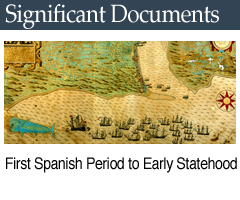Thomas Sidney Jesup Diary
Significant Entries
1836
- October 16
- Thomas Sidney Jessup takes command of U.S. troops south of the Withlacoochee River in Florida.
- November 27
- Jessup learns of his appointment as commander of all U.S. troops operating in Florida against the Seminoles.
- December 3
- Lieutenant Colonel David Caulfield captures 41 black Seminoles after destroying their towns near the Ocklawaha River.
- December 24
- Jesup writes to Creek leader Echo Harjo requesting that he provide 100 warriors for the campaign against the Seminoles.
1837
- January 10
- Jesup reports the capture of 16 black Seminoles near the Panasoffkee Swamp.
- January 24
- Jesup reports an engagement in which the Seminole leader Cooper (Osuchee) is killed and 17 of his people captured.
- January 28
- Jesup reports the capture of “several hundred” head of Seminole cattle near the Withlacoochee River.
- January 31
- The black Seminole Abraham, interpreter for Micanopy, meets with Jesup. He explains that the Miccosukees caused the war and that Micanopy’s people desired peace and to remain in Florida.
- February 3
- Jesup meets with the Seminole leader Jumper (Otee Emathlar), who echoes the sentiment that the Miccosukees started the war. Jumper expresses dissatisfaction with lands assigned to the Seminoles in the west. Jumper promises to assemble other leaders for a conference with Jesup on February 18.
- February 10
- Jesup reports the death of John Caesar, one of the principal black Seminole leaders.
- February 23
- Holatoochee (Davy), Cloud (Yaholoochee), Alligator (Halpatter Tustenuggee) and other Seminole leaders meet with Jesup.
- March 5-6
- Holatoochee, Jumper, Cloud and other Seminole leaders inform Jesup that they intend to bring their property (cattle, slaves) with them if they agree to emigrate. Jesup declares that all Indians found north of the Hillsborough River will be considered hostile. Jesup agrees to compensate Seminoles for their cattle, and to allow blacks to accompany them west.
- March 11
- Jesup learns that Creek Indians friendly to the United States may have joined the hostile Seminoles after abuses suffered by their families in Alabama.
- March 18
- Micanopy agrees to the articles of capitulation negotiated by Jumper, Holatoochee and Cloud in early March.
- April 5
- Holata Micco (Billy Bowlegs) meets with Jesup. He informs the General of his desire for peace, but unwillingness to emigrate.
- April 28
- Jesup meets with Micanopy, Jumper and Alligator. He informs them that all Indians failing to assemble for emigration will be held responsible for property damaged during the war.
- May 2
- Jesup reports that Tustenegee Harjo (Mad Warrior) informed him about a dance to be held at his camp. According to Jesup, "[t]he dances of the Indians appears to be one of their religious ceremonies…they fast the whole of the day preceding, and take medicine…the ceremony seems to be a[n]…ancient one…altogether what they call a purification."
- May 5
- Having heard nothing from the Seminoles, Jesup laments that "[t]he emigration is becoming hopeless."
- May 14
- Jesup orders the destruction of villages and crops belonging to Indians who refuse to assemble for emigration.
- May 18
- Jesup learns that a group of Creek Indians friendly to the United States, headed by Echo Harjo, met with Powell (Osceola), Coacoochee (Wildcat) and Sam Jones (Abieka) near the Saint Johns River. They agreed to come in, but expressed great difficulty in assembling their people. Osceola describes the Miccosukees, who refused to cooperate, as a "band of wild hogs."
- May 23
- Indians from the Peas (Peace) Creek region arrive with 17 black Seminole captives.
- May 26
- Jesup receives information from Powell that the Miccosukees will not surrender and will likely resume hostilities.
- May 28
- Jesup is informed that Micanopy has been replaced by Sam Jones (Abieka) as the principal leader of the Seminoles.

 Listen: The World Program
Listen: The World Program


